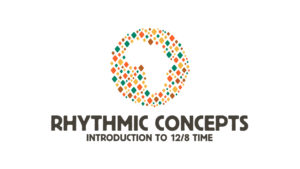In this post, we’re going to revisit our Introduction to 4/4 Time video, which is our attempt to explain what the term ‘4/4 time’ means, and how it relates to African drumming – you can find this video in the Technique > Rhythmic Concepts section of African Drumming Online:
https://africandrummingonline.com/technique/rhythmic-concepts/
We thought it would be a good idea to develop a blog series where we take some of our most popular free videos, and distill the info into text form as best we can. Different people learn in different ways, so we hope this helps some of you!
Not yet a member? You can sign up free to get access to this video, here:
https://africandrummingonline.com/
If you’re new to playing a musical instrument, and haven’t learned theory before, you have probably heard people refer to rhythms as being in ‘4/4’, ‘in 4’, or some variation thereof, and it has probably been confusing! Hopefully this explanation will help…
When people refer to ‘4/4’, they are referring to what’s called a ‘Time Signature’. Literally, the 4/4 time signature means that there are four ‘quarter-length’ notes in each bar. There are many different time signatures, and they all work in the same way – 9/8 means nine eighth-length notes in each bar, 17/16 means seventeen 16th-length notes in a bar, etc. In itself this might not help yet, but it’s good to know that this is the format of time signatures, and that’s really all they mean.
When learning African drumming, I have found that nearly every rhythm I have learned, I have understood as being either 4/4 or 12/8 (twelve eight-length notes in a bar), so we only really need to focus on those for now.
If you haven’t heard of notes and bars before, I recommend checking out the first Rhythmic Concepts video – Introduction to Beat, Pulse and Bars – also in the Rhythmic Concepts section of African Drumming Online. To briefly recap, a ‘bar’ is basically an arbitrary measurement of a period of time within music – as an example, if we were to count 1, 2, 3, 4, 1, 2, 3, 4 in time with a song on the radio, each count to four could be one ‘bar’.
In the context of African drumming, a lot of the support parts and rhythms are repeating patterns, and one bar is often one cycle, or repeat, of a pattern. Sometimes a single pattern will spread over two or more bars, but often a ‘cycle’ can be thought of as one bar.
So, once we accept that a bar is a period of time in music, the time signature just tells us how much stuff is in each bar. A lot of the differences between different time signatures is purely academic and relates only to how music is written down, so I’m going to keep it simple.
In short, 4/4 means that for each bar of the rhythm, there are four equal beats, each for the length of a ‘quarter’ note (to make it confusing and circular, a ‘quarter note’ is technically defined as being a quarter of a bar of ‘common time’, but lets’ not worry about that). Put simply, this means, for each bar, you can count: 1, 2, 3, 4.
The other important bit that defines 4/4 rhythms is the way that the four beats are broken down – each beat – 1, 2, 3, 4 – can be divided into ‘subdivisions’. In 4/4 time these subdivisions are multiples of two, normally up to four. This means that our bar of four quarter-length notes can also be thought of as eight eighth-length notes, or 16 16th-length notes – these are all equivalent, in a practical sense.
This means that if you’re counting along to a bar of 4/4 and want to instead hear 8/8, you could count 1 and 2 and 3 and 4 and – where each ‘and’ is halfway between the beats. Here’s what I mean in the video:
Alternatively, if you wanted to feel even smaller subdivisions, we could head the bar as 16/16 – dividing each beat into a further 4 hits, which we would count as ‘1 e and a 2 e and a 3 e and a 4 e and a’. Here’s the example:
All of these ‘feels’ comprise 4/4 time – the common idea is that 4/4 time has four main beats divided by subdivisions of two or four (or large multiples).
Hope that helps! I recommend watching the video to make it clearer…






[…] What is 4/4 Time? – Video Summary […]